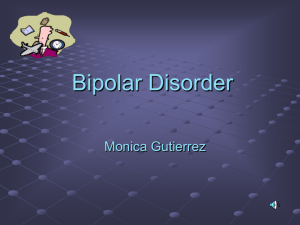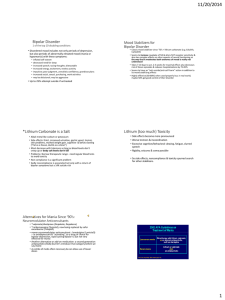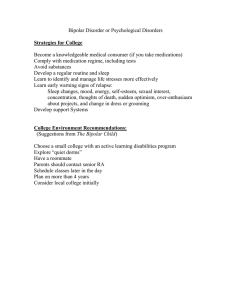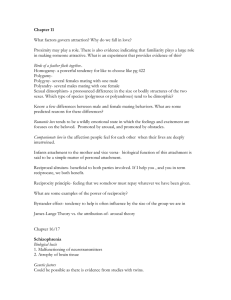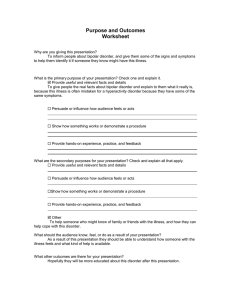Bipolar - Dr. Keith Kesler, DO
advertisement
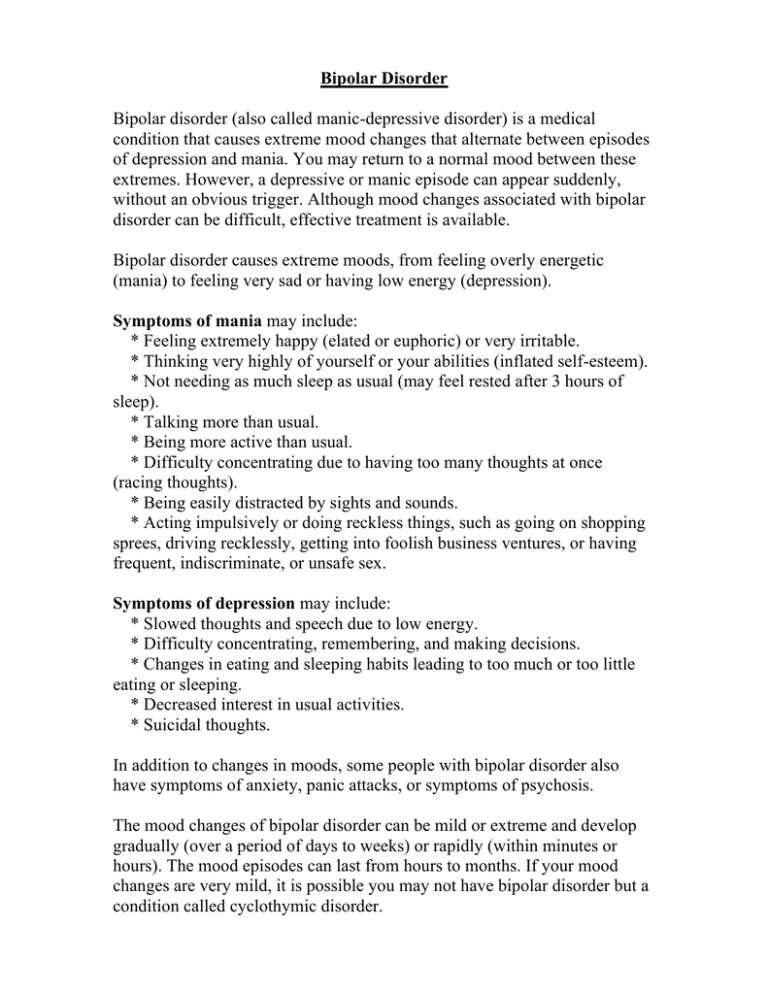
Bipolar Disorder Bipolar disorder (also called manic-depressive disorder) is a medical condition that causes extreme mood changes that alternate between episodes of depression and mania. You may return to a normal mood between these extremes. However, a depressive or manic episode can appear suddenly, without an obvious trigger. Although mood changes associated with bipolar disorder can be difficult, effective treatment is available. Bipolar disorder causes extreme moods, from feeling overly energetic (mania) to feeling very sad or having low energy (depression). Symptoms of mania may include: * Feeling extremely happy (elated or euphoric) or very irritable. * Thinking very highly of yourself or your abilities (inflated self-esteem). * Not needing as much sleep as usual (may feel rested after 3 hours of sleep). * Talking more than usual. * Being more active than usual. * Difficulty concentrating due to having too many thoughts at once (racing thoughts). * Being easily distracted by sights and sounds. * Acting impulsively or doing reckless things, such as going on shopping sprees, driving recklessly, getting into foolish business ventures, or having frequent, indiscriminate, or unsafe sex. Symptoms of depression may include: * Slowed thoughts and speech due to low energy. * Difficulty concentrating, remembering, and making decisions. * Changes in eating and sleeping habits leading to too much or too little eating or sleeping. * Decreased interest in usual activities. * Suicidal thoughts. In addition to changes in moods, some people with bipolar disorder also have symptoms of anxiety, panic attacks, or symptoms of psychosis. The mood changes of bipolar disorder can be mild or extreme and develop gradually (over a period of days to weeks) or rapidly (within minutes or hours). The mood episodes can last from hours to months. If your mood changes are very mild, it is possible you may not have bipolar disorder but a condition called cyclothymic disorder. The cause of bipolar disorder is not known. It may run in families. Bipolar disorder may be linked to problems in the balance of chemicals in the brain. It may also be linked to problems with how the endocrine system works. Another theory is that the structure or size of certain parts of the brain may be abnormal. Bipolar disorder is common and occurs equally among males and females. Over 3 million Americans—about 1% of the population—suffer from bipolar disorder, with similar rates existing in other countries. Bipolar disorder often begins between the ages of 15 and 24, although diagnosis and treatment may not begin until several years later. Certain childhood attention disorders can mimic symptoms of bipolar disorder. Research is ongoing to determine whether a connection exists between attention-deficit hyperactivity disorder (ADHD) and bipolar disorder. Regardless, while symptoms can be similar, ADHD is a separate disorder that is very different from bipolar disorder and has different treatment. Although most cases of ADHD are not related to bipolar disorder, ADHD can occur along with bipolar disorder in children. Bipolar disorder can be effectively treated. Treatment of bipolar disorder includes medication and psychotherapy. Learning to recognize the early symptoms of your manic and depressive episodes can help, because early treatment can reduce their impact on your daily life. If bipolar disorder is not treated, it can lead to serious illness, more extended treatment, and even death due to suicide or reckless or risky behavior. 25-50% of people with a mood disorder such as bipolar disorder will attempt suicide. There is a twenty-fold increase in suicide rates in patients with mood disorders when compared to people without a mood disorder. The rate of suicide increases with the use of alcohol and substances. It is also important that your family members learn about the disorder or get supportive counseling because bipolar disorder greatly affects the entire family. It is very common for substance abuse problems to be present along with bipolar disorder. Substance and alcohol abuse is present in 32 percent of individuals with depressive disorders and 56 percent of those with bipolar disorder. Substance abuse frequently occurs in the manic state and complicates treatment of bipolar disorder—sometimes the medications used to treat bipolar disorder will not work as well if drug or alcohol use or abuse is present. Alcohol or drug abuse problems may also be one reason that a person who has bipolar disorder has difficulty taking medications regularly. Types of bipolar disorder: * Bipolar I. If you have bipolar I, you will experience episodes of depression along with at least one manic episode. Depression may not be triggered by a stressful life event. You may not be able to identify why you started feeling sad, tired, or indecisive. The depression may last for a short time or for months. You may then go back to feeling normal for a time, or you may go right into a manic episode. During mania, you will feel less need to sleep, will have high energy, and will sometimes feel irritable. Mania can also cause you to feel invincible, which can lead to dangerous behaviors, such as driving too fast or spending too much money. * Bipolar II. If you have bipolar II, you will experience depression just as in bipolar I. However, the episodes of mania are far less severe (hypomania). Bipolar II is more common in women and possibly more common during the time right after a woman has had a baby (postpartum period). * Mixed bipolar disorder. In mixed bipolar disorder, episodes of depression and mania rapidly alternate throughout the day for at least one week. Symptoms include sadness, euphoria, and irritability. Other symptoms can include agitation, lack of sleep, appetite changes, and possibly, thoughts of suicide. This makes the disorder challenging to treat and very frustrating for you and for those around you. Mixed bipolar disorder can lead to hospitalization if daily functioning becomes impaired. * Rapid-cycling bipolar disorder: If you have rapid-cycling bipolar disorder, you will experience at least four episodes of depression, mania, or both within a 12-month period. You may go directly from an episode of depression to an episode of mania, or you may have a short time lapse between the two moods. The mood swings are the same as with other types of bipolar, but the frequency of mood swings distinguishes rapid-cycling bipolar disorder from the other subtypes. Bipolar disorder can be passed down through families (genetic risk). If anyone in your family has been diagnosed with bipolar disorder, your risk of developing it is increased. Tips for Living with Bipolar Disorder Become an expert on your illness Read books, attend lectures, talk to your therapist, and become knowledgeable about the symptoms and treatment of bipolar disorder and its effects on you and your family. How do I feel today? Another tool that some therapists recommend is a mood chart, in which you record your moods and their changes over a period of months. Think about it: getting to know yourself better, and taking an interest in your emotional life in this way can be very helpful. Tracking your mood swings can help you develop the capacity to observe the subtle changes in your mood and be more objective about these changes. Take care of your body There's no getting around it: caring for your body will make a big difference in your mood swings and your mental health. Going to bed at the same time every night and waking up about the same time every morning is a start towards creating a regular rhythm in your life. Eat a low-fat diet. Exercise every day. Do not use alcohol or illicit drugs. Use Omega 3 fatty acids. Research has been promising in the daily use of 3-5 grams of Omega-3 to reduce symptoms. Self-management People who have experienced hypomania often know the signs and can help prevent or minimize an episode by: • Getting plenty of sleep. Have a regular bedtime and stick with it. • Avoiding stimulants such as caffeine. • Trying to bring on a sense of calm. Meditation helps. • Avoiding major decision-making during a manic episode. • Avoiding spending sprees if you feel an episode coming on. Some of the most persistent problems for people with bipolar disorders involve types of thinking that are irrational and difficult for others to understand. When they learn to recognize and name these "thought errors," it can help them avoid making a scene, getting embarrassed, and getting in trouble. Once you can label and dissect an irrational thought, you take away some of its power. The longer these patterns are allowed to continue, however, the more likely they are to become ingrained, lifelong habits. These habits of thought contribute to development of the hard-to-treat personality disorders that often bedevil bipolar adults. Psychotherapy is helpful in changing these thought patterns. Problematic thought styles include: * Catastrophizing. Seeing only the worst possible outcome in everything. * Minimization. Another side of catastrophizing, this involves minimizing your own good qualities, or refusing to see the good (or bad) qualities of other people or situations. People who minimize may be accused of wearing rose-colored glasses, or of wearing blinders that allow them to see only the worst. If a person fails to meet the minimizer's high expectations in one way-for example, by being dishonest on a single occasion--the minimizer will suddenly write the person off forever, refusing to see any good characteristics that may exist. * Grandiosity. Having an exaggerated sense of self-importance or ability. * Personalization. A particularly unfortunate type of grandiosity that presumes you are the center of the universe, causing events for good or ill that truly have little or nothing to do with you. * Magical thinking. Most common in children and adults with obsessivecompulsive disorder, but seen in people with bipolar disorders as well. Magical thinkers come to believe that by doing some sort of ritual they can avoid harm to themselves or others. The ritual may or may not be connected with the perceived harm, and sufferers tend to keep their rituals secret. * Leaps in logic. Making seemingly logic-based statements, even though the process that led to the idea was missing obvious steps. Jumping to conclusions, often negative ones. One type of logical leap is assuming that you know what someone else is thinking. * "All or nothing" thinking. Being unable to see shades of gray in everyday life can lead to major misperceptions and even despair. A person who thinks only in black-and-white terms can't comprehend small successes. * Paranoia. In its extreme forms, paranoia slides into the realm of delusion. Many bipolar people experience less severe forms of paranoia because of personalizing events, catastrophizing, or making leaps in logic. * Delusional thinking. Most of the other thought styles mentioned above are mildly delusional. Seriously delusional thinking has even less basis in reality, and can include holding persistently strange beliefs. . The following information is excerpted from “A Consumer Speaks Out”: “Bipolar disorder is often inherited. It’s been treated as a physical illness for less than 40 years, and, therefore, many of us were raised among undiagnosed adults with this illness who were abusive, negligent, or substance abusers.” “Not every problem in the life of a person with bipolar disorder comes from the bipolar chemical imbalance. People with bipolar disorder and their therapists must understand this, first and always. We cannot always control our feelings or "chemical mood," but we are more than just chemical reactions. Talking therapy can change behavior and thought patterns, which people with bipolar disorder have spent a lifetime developing.” “Bipolar disorder is living with a mind you can’t trust. What clinicians call "mood swings" are, to us, changes in who we are. They occur without reason or notice and are completely outside our control.” “Manic episodes, whether violent, irritable, or euphoric, often feel as if the "real you" is watching some disconnected mad person lose all control and inhibition. It can feel good: social, talkative, energetic, everything bright, clear, and beautiful. It can be hell: suicidal, every noise grating, every light too bright, every person painfully annoying. Thoughts can circle incessantly or clang from one track to another uncontrollably.” “Depression leaves you feeling worthless and helpless, no place you want to be, nothing you want to do, no one you want to be with. Dishes, laundry, bill paying, even bathing can become overwhelming. Suicidal feelings come in long sieges, not manic impulses or flashes.” “Finally, people with bipolar disorder must learn the difference between manic euphoria and real happiness. Mania can feel fun, carefree, powerful, exhilarating, but when the mood dissolves, there is nothing left except despair, regret, shame, humiliation, and often debts to repay. Many of us resist treatment because we’re afraid medicine will take all the fun out of life. We think life without mania would be boring and the inevitable crash from the heights is worth it.” “The key to jumping this hurdle is the concept of joy. There is no joy in mania. Joy comes from achievement, love, loved ones, nature, family, work, or friendship. Warmth, security, and peace are still there when the mood shifts. Real happiness makes the people closest to you happy. Manic euphoria makes those same people instinctively nervous, angry, and irritable.” “Scheduling isolated, controlled, sympathetic "mood management times" lets you release tension in a safe way. Isolation is important because you can’t really let go if other people are around. Controlled means a conscious decision about how you will acceptably act on eccentric feelings that you can’t avoid. There are hundreds of ways, like exercise or meditation. Ken sings or talks out loud (alone). Kristen puts on headphones each day, selects music, and just rides with it.” Information Compiled from the Following Sources: WebMD http://my.webmd.com.hw.bipolar_disorder/ty1019.asp Tips for Living With Bipolar Disorder http://www.bipolar-disorders.com/html/living_with_bpd.php3 A Consumer Speaks Out http://www.pendulum.org/articles/articles_misc.consumer.html Thought Errors http://www.patientcenters.com/bipolar/news/thought_errors.html Suicide and Substance Abuse http://www.mhsource.com/bipolar/subuse.html This URL is an excellent clearinghouse for information: http://www.psycom.net/depression.central.bipolar.html ** Disclaimer: All information contained in this packet is meant for educational purposes only and does not replace advice and/or treatment from a physician. We are not responsible for the content of the websites listed.**
